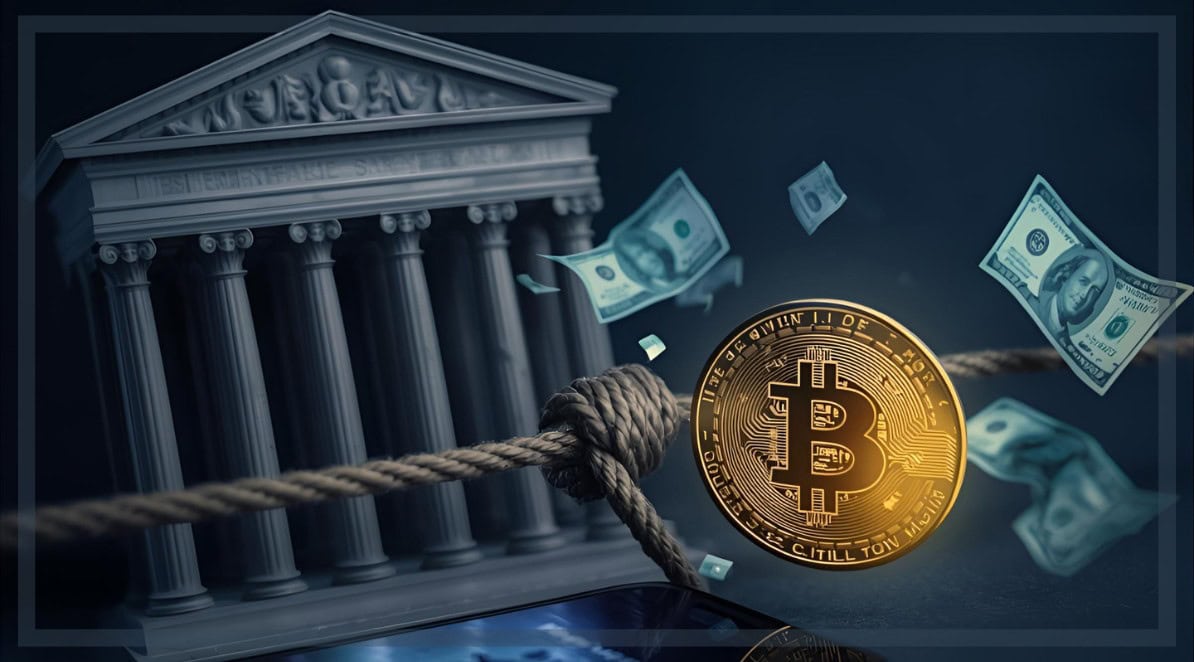Why Banks Are Fighting Stablecoin Interest Payments
A fierce conflict is unfolding over whether Americans should earn interest on their stablecoins (digital tokens pegged to the US dollar). Traditional banks are pushing regulators to stamp out these yields, fearing an exodus of deposits into crypto platforms. Bank lobbyists argue that interest-bearing stablecoins could siphon trillions of dollars out of the banking system and into less regulated exchanges, with some trade groups warning of as much as $6 trillion in potential outflows if rewards persist. They frame this not just as competition, but as a threat to the flow of loans and credit that banks provide, a point echoed in coverage of the banks’ warnings about a multi-trillion-dollar shift into stablecoins.
“Permitting [stablecoins] to provide benefits tantamount to interest… could cause a shift… that would cause [users] to view [them] as a longer-term store of value,” a coalition of major banking groups — The Consumer Bankers Association, American Bankers Association, Bank Policy Institute, Independent Community Bankers of America, and Financial Services Forum — warned, adding that large-scale adoption could spark “deposit flight” from banks. They caution that, unlike bank accounts, stablecoins lack federal deposit insurance, so ordinary people could be exposed if an issuer fails. Bank advocates also note that if deposits flee, fewer funds would be available for banks to lend, potentially raising borrowing costs in the wider economy.
For all these reasons, banks want a level playing field: since Congress banned stablecoin issuers from paying interest, they insist that crypto exchanges and affiliates should be forbidden from sneaking around that rule with “rewards” programs. Early this November, banking industry groups formally urged the U.S. Treasury to “close the stablecoin interest loophole” when implementing the new law, framing it as necessary to “protect the flow of credit…and the stability” of the financial system and to uphold Congress’s intent that no yield be paid on payment stablecoins.
🚨Federal Reserve Gov. demands stablecoins should NOT pay yields to customers… because rewards belong to …the banks?🔥@tyler @cameron @brian_armstrong @EleanorTerrett @thatgerald @JohnEDeaton1 @vladtenev @Gemini pic.twitter.com/eGVgG9NaCi
— Paul Barron Network (@paulbarrontv) October 22, 2025
The GENIUS Act and the Claimed Loophole in the Law
At the heart of this fight is the Guiding and Establishing National Innovation for U.S. Stablecoins (GENIUS) Act, a landmark stablecoin law signed in July 2025. This law pulled stablecoins into the regulatory fold by requiring them to be fully backed by safe assets and treating them as a form of “digital cash.” To reinforce that idea, Congress barred stablecoin issuers from paying interest: the thinking was that a digital dollar shouldn’t double as an investment product.
However, in what has become a pivotal nuance, the GENIUS Act does not forbid crypto exchanges or other intermediaries from offering rewards on stablecoin holdings. In practice, that meant companies like Coinbase or PayPal could give customers a yield on their stablecoins even if the token issuer itself couldn’t. Today, for example, Coinbase offers about 4% annual reward on USDC stablecoin deposits, and other platforms advertise rates above 5% — on par with or higher than many bank savings accounts.
Banks see this as a glaring loophole that undermines the law’s intent. They contend that stablecoin providers are essentially doing an end-run around the ban by relabelling interest as “rewards” or “loyalty points.” Regulators are now caught in the middle. As of this month, the Treasury Department is drafting rules under the GENIUS Act, and it has been flooded with comment letters from both sides. Banking associations are urging a strict interpretation that extends the interest ban to any “transfers of value” to stablecoin holders, no matter who pays it. They argue this is needed to prevent massive shifts of money into stablecoins. One widely cited analysis by bank lobbyists suggested up to $6.6 trillion in deposits might move out of banks if yield-bearing stablecoins take off.
Crypto firms, meanwhile, are pleading with regulators to stick to the letter of the law and not “gold-plate” it with extra restrictions. Coinbase’s public letter to the Treasury emphasizes that Congress deliberately drew the line at the issuer and allowed third-party rewards, and changing that now would “rewrite Congress’s carefully-drawn lines” and hurt consumers by stripping away market incentives. This difference in interpretation has effectively turned a one-paragraph provision into a regulatory tug-of-war.
The big banks are coming for another bailout by attacking crypto.
— Coinbase 🛡️ (@coinbase) September 29, 2025
They don't want you to earn rewards on your stablecoin holdings.
Our take: competition = better options for consumers.
If you wouldn’t ban credit card rewards, don’t ban crypto rewards. pic.twitter.com/ALu1luU7sx
Coinbase CEO Brian Armstrong Adds His Thoughts
Coinbase CEO Brian Armstrong contends that banks should simply compete on a level playing field. He frames the banking industry’s push as defensive, allegedly protecting an $180 billion annual profit from payment services rather than a genuine concern about financial stability.
There’s a kernel of truth here. Major banks offer notoriously poor savings rates. Community banks increasingly pass on regulatory compliance costs to customers. The crypto industry successfully identified a genuine gap in consumer value. The problem isn’t that the gap exists — it’s that filling it creates externalities the banking system can’t absorb.
Retail Investors and Advocates Push Back
On the other side of the fight, crypto advocates and many retail investors are rallying to protect the right to earn yield on stablecoins. They argue these interest-like rewards are a fair and innovative way for ordinary people to get more out of their digital dollars, especially when fully backed stablecoins function much like cash in the bank.
Stand With Crypto, a prominent grassroots advocacy group, has been leading the charge on behalf of consumers. The organization, described as “America’s leading crypto advocacy organization,” mobilizes everyday crypto users to make their voices heard in Washington. One of its top priorities this year has been pushing for stablecoin adoption and the ability for users to earn interest, rather than letting only big financial institutions reap the benefits of blockchain-based finance.
Last month, Stand With Crypto launched a nationwide letter-writing campaign that sent over 250,000 messages to U.S. senators, countering Wall Street’s lobbying. Their letters implored lawmakers to leave the GENIUS Act’s language intact. In other words, to allow the stablecoin rewards to continue as Congress intended. “Lawmakers chose to protect rewards because they know they are for consumers,” the letter read, warning that “a ban on rewards would stop consumers from earning value on fully backed digital dollars” even as banks fight to preserve their own credit-card perks.
The advocates point out a seeming irony: Banks have fiercely protected their own credit-card reward programs, yet now lobby to quash comparable rewards for stablecoin users. From the crypto corner, allowing modest yields on stablecoins will boost competition and innovation, pressuring banks to offer better rates and services for everyone. They also note that stablecoin issuers under the new law must hold high-quality reserves and meet rigorous standards, which proponents say makes these digital dollars safe enough to earn interest without endangering consumers.
In short, crypto lobbyists and grassroots groups are pushing back hard against what they view as banking industry overreach. Stand With Crypto’s swelling ranks, now reportedly over 2.7 million members strong, reflect a public constituency that doesn’t want banks to monopolize the opportunity to earn yield.
Crypto represents a new era of finance, powered by people and open to everyone.
— Stand With Crypto🛡️ (@standwithcrypto) September 29, 2025
Big Banks want to stop us from disrupting their monopoly. They're lobbying to ban our right to earn crypto rewards on Stablecoins.
Don't let them: https://t.co/J9LjcHpxre pic.twitter.com/JgQWVY0tTs
A High-Stakes Clash Over the Future of Digital Dollars
This fight over stablecoin interest has quickly escalated into a high-stakes showdown between old-guard finance and a new wave of digital currency innovation. One former lawmaker Patrick McHenry, Republican representative of North Carolina, ex-chair of the House Financial Services Committee, called it “a trillion-dollar fight” over territory the banks have long jealously guarded. The outcome will set a crucial precedent: Will stablecoins remain purely transactional tools, like digital cash with no interest, or will they also be allowed to serve as digital savings vehicles for the public?
Banks insist that reining in stablecoin yields is about protecting consumers and financial stability, ensuring that money stays in insured banks that support the economy. Crypto advocates counter that it’s really about protecting bank profits, and that Americans deserve access to the same kind of interest on “fully-backed digital dollars” as banks generate for themselves.
Policymakers now face the task of balancing these concerns. As regulators draft rules and lawmakers contemplate next steps, both sides are making their case in plain terms, avoiding arcane financial jargon to drive home what’s at stake for ordinary people. The debate extends beyond technical details and reaches a core question: Who gets to capture the yield on a digital dollar — Wall Street or the everyday saver?
The coming months will reveal whether compromise is possible, or if this tug-of-war will redefine the relationship between traditional banks, emerging crypto services, and the rights of retail investors in a changing financial landscape.
#Crypto #Blockchain #DigitalAssets #DeFi #Stablecoin #WallStreet #StandWithCrypto
Author: Ayanfe Fakunle
The editorial team at #DisruptionBanking has taken all precautions to ensure that no persons or organizations have been adversely affected or offered any sort of financial advice in this article. This article is most definitely not financial advice.
See Also:
Who are the original pioneers of the stablecoin? | Disruption Banking
Tether’s Big Bet: Stablecoins as the New Global Reserve Power | Disruption Banking
Stablecoins are Quietly Rewiring U.S. Banking but are Banks Ready for It? | Disruption Banking













